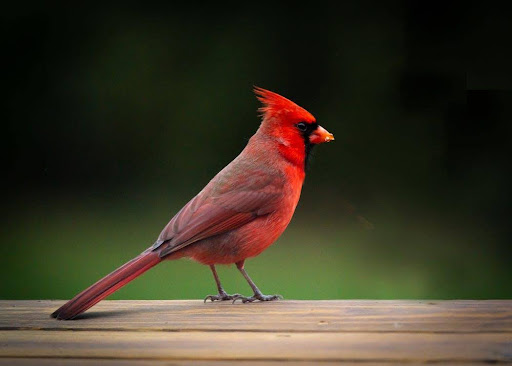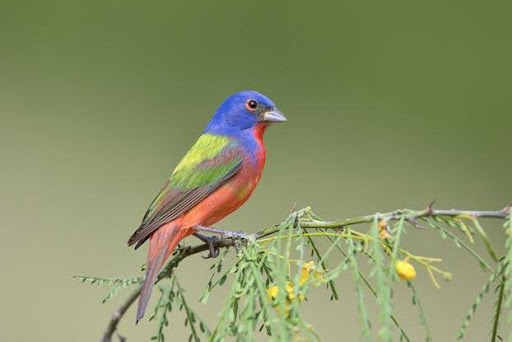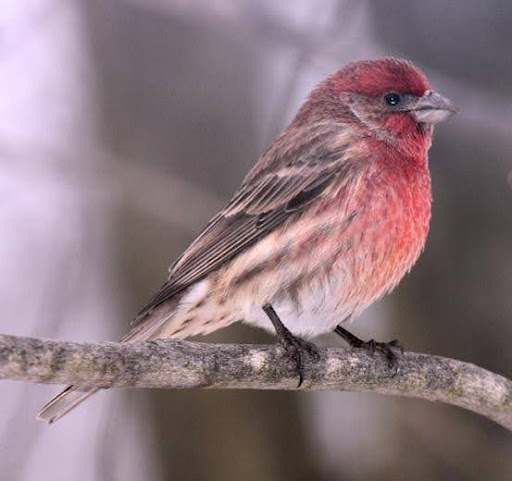Written by: Jorge Garcia, Naturalist
One of the most fascinating things about our feathery friends, the birds, is the stunning and beautiful colors some of them display. For example, let’s take a look at two River Legacy species – the painted bunting (Passerina ciris) (Figure 2), which is here in the summer months, and the northern cardinal (Cardinalis cardinalis) (Figure 1), which graces us with its beauty all year long. Male painted buntings have an array of different shades of red, blue, and green while male
northern cardinals sport a very bright red that makes them relatively easy to spot if you’re birding at River Legacy. It is typically the males that have these bright colors though that is not always the case.


Figure 1. Male northern cardinal (Cardinalis cardinalis)
Figure 2. Male painted bunting (Passerina ciris)
Scientists have researched the science of bird coloration for years and we will delve a bit into that today. The reason why feather colors are as diverse as they are is because of the presence of organic pigments found inside the feather cells. These are chemicals found at the nanometer scale and they absorb the energy of certain wavelengths of light and reflect the wavelengths corresponding to the colors that we see. Bird feathers contain 4 major classes of pigments: melanins, carotenoids, psitacofulvins, and porphyrins. Melanins are responsible for grays, blacks, browns, and similar colors. Carotenoids produce bright yellow, orange, red, and purple colors.
sittacofulvins are responsible for the yellow, orange, and red feather colors but only in parrots (order Psittaciformes). Porphyrins produce bright, olive green, and magenta colors in the turacos (order Musophagiformes)-a bird order native to sub-Saharan Africa-and other groups of birds. A possibility exists that another class of pigments, the pterins, exist in penguins (order Sphenisciformes) but scientists are still trying to confirm that! The diversity of structural colors that we see in the birds around us comes about because of physical, optical interactions between these pigments and light.
There are two types of melanin – eumelanin which gives black and gray colors and pheomelanin that gives red brown, rufous, and tan colors. Here is a cool fact about these two types of melanin: they are the ones responsible for hair color in humans (Homo sapiens)! Research has shown that melanins also help a feather’s resistance to degradation by keratin-eating bacteria. This is likely one of the reasons why birds in wetter climates (where more bacteria are found)
tend to be darker in coloration than birds in drier climates.
Carotenoids come originally from plants and birds obtain them through their diet. These pigments play a significant role in the colors of the iconic, aforementioned species, the northern cardinal and the painted bunting. 39 carotenoids in birds have been identified and the more common ones are -carotene, lutein, and zeaxanthin. Another interesting thing about carotenoids is the fact that the colors they produce can also be influenced by the way in which the molecules are bound inside the feather. There are situations where the same carotenoid produces a red color in one species versus purple in another species due to this.
Psittacofulvins are exclusively found in parrots. The reason why parrots evolved the usage of these exclusive pigments is currently poorly understood. Porphyrins are pigments related to hemoglobin, found within our cells, and chlorophyll, found within plants and a few other organisms. Turacos predominantly use these pigments, but they have been found in at least 13 orders of birds, including one order that has River Legacy representatives – the owls.
Scientists have come up with many explanations as to the reason behind these pigments being present on birds and producing the colors we see. It is possible that a brighter color indicates that a particular bird is healthier. This could become important when females are selecting a mate. A brighter red hue in either a male northern cardinal or a male house finch (Haemorhous mexicanus)-a River Legacy species all-year round-(Figure 3) could be an indicator of fitness of a male for a nearby female.
Though this has been a thorough dive into the chemicals responsible for bird colors, it is far from the complete story. Some birds also have iridescence, which is a change in color depending on the angle of observation. Some birds have been shown to exhibit ultra-violet colors, which are not visible to the naked eye.

Figure 3. Male house finch (Haemorhous mexicanus)
If you want to see some of the birds mentioned in this article and other species with different colors, we invite you to come over and participate in the 2024 Great Backyard Bird Count at River Legacy on Saturday, February 17th, 2024 from 10 A.M. to 2 P.M. There will be different stations around the Nature Center where you can become a citizen scientist, by partaking in birdwatching and bird-counting. These will be manned by professional birders who can help you identify what you are seeing! In addition, there will be other activities, including kid-friendly activities, that we will have to celebrate the avian world! The bird wall of diversity will be a cool feature where you can see the different colors of birds from all the living bird orders. When you are standing there looking at it, you will now know the scientific mechanism as to how those colors are being produced!
Sources:
Gill, F.B. & Prum, R.O. (2019). Ornithology. 4 th edition. W. H. Freeman and Company.
